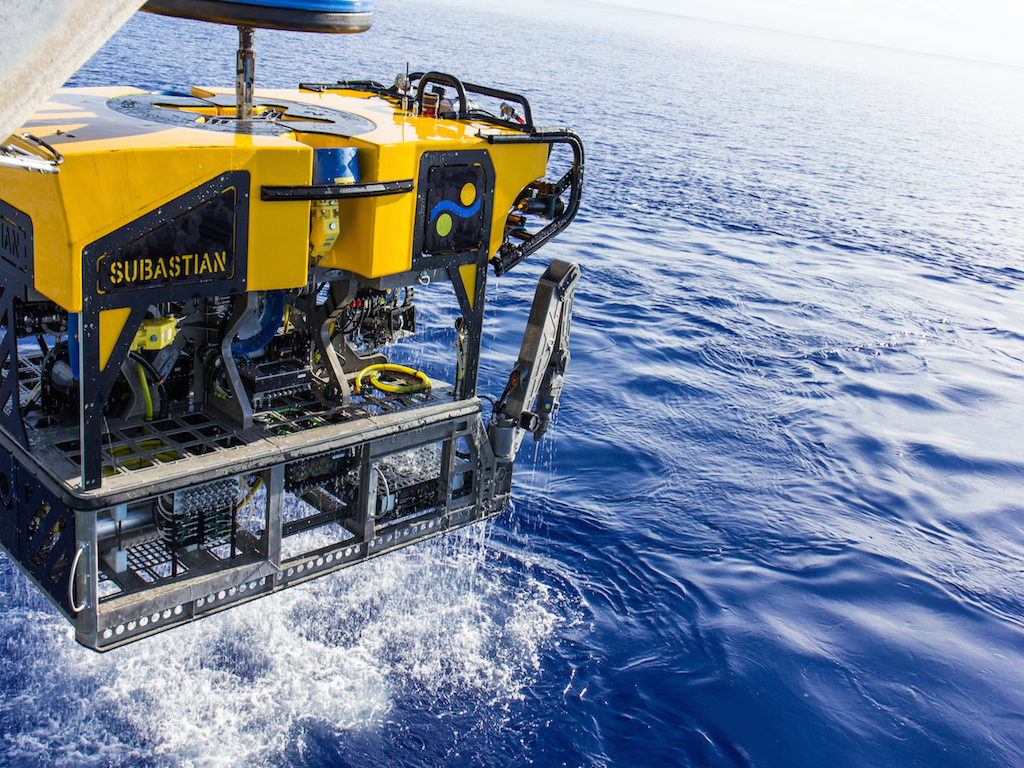The growth of remotely operated vehicles (ROVs) and other digitally driven undersea technologies can give ocean scientists immensely wider reach, at a time when demand is growing to map the sea floor, say organizers of the National Ocean Exploration Forum.
“A lot of the difficulty with ocean exploration since Ulysses is we move slowly at sea,” said Jesse Ausubel, director of the Program for the Human Environment at Rockefeller University in New York. With ROVs and autonomous probes, “we think we can multiply by a factor of 5 or 10 the area and speed we can cover.”
ROVs and new technologies are a major focus of the forum, being held in New York Thursday and Friday. Mandated by Congress to update progress on U.S. ocean exploration, the event is titled “Beyond the Ships: 2020-2025,” focusing on what will likely happen in the next decade.
The conference aims to map out priorities for undersea exploration in those years, with particular interest in the U.S. southeast Atlantic waters, the Gulf of Mexico, and the Arctic.

ROV Deep Discoverer, operated by the National Oceanic and Atmospheric Administration. NOAA photo.
A big part of that will be the continuing shift toward a “mother ship” model, with smaller, cheaper robotic vehicles deployed from single, crewed surface vessels. Autonomous craft are emerging across the maritime industry, and the scientific research community have been early and enthusiastic adopters.
“We’ll continue to use ships but will have much more reliance on drones and other new technologies,” Ausubel said in a Wednesday conference call with reporters.
“It will be a major focus of this meeting,” said Paul Gaffney, a retired Navy vice admiral and ocean policy fellow with the Urban Coast Institute at Monmouth University. “One can think about this as opening the aperture much wider than a single ship can.”
Undersea drone craft can carry cameras, perform chemical analysis and needle biopsies of sea floor life, and collect environmental DNA to identify species. Over the past year that kind of technology helped new surveys of West Coast marine sanctuaries, from the Olympic Coast down to the Farallon Islands and Channel Islands.
A keynote speaker is explorer Robert Ballard, famed for his expeditions to the deep Atlantic Ocean wrecks of the liner Titanic and battleship Bismarck. He worked closer to shore last summer on his 211’x34.5’ exploration vessel Nautilus.
The West Coast discoveries included new species, and some 500 seafloor methane seeps that might indicate future gas resources — and force a recalculation of how naturally emitting methane is contributing to atmospheric warming.
Gas seeps emerge near the Cascadian subduction zone — where the continental plates meet below the sea floor — and were mapped using new sonar technology, said Bob Embly of the National Oceanic and Atmospheric Administration’s Pacific Environmental Laboratory.
Only 10% to 15% of the zone was surveyed and “we saw hundreds of individual bubble streams coming up from the sediment,” Embly said.
Calculating the volume of methane emissions is a task for future research, and Embly said the use of small submersibles and remote sensing can do more of that work at lower cost. “Using a surface ship is expensive.”
Those new vehicles include heavyweights like the ROV SuBastian, a 6,500-lb. deep-sea research platform carried on the Schmidt Ocean Institute’s 272’x43’x16’ research vessel Falkor. Equipped with ultra-high resolution cameras, mechanical arms and a lighting system equivalent to 150 automobile high beams, the ROV can operate at depths up to 2.8 miles.
At the other end is a suitcase-sized swimmer, a “curious exploration robot” developed at the Woods Hole Oceanographic Institute. Programmed to focus on every thing unfamiliar to its data bank brain, the prototype in a recent test off Panama discovered a previously unseen and enormous population of crabs.
The potential for swarms of robotic explorers, reporting back to shipboard data hives, could bring immense economic potential from such resource discoveries, conference organizers said. For example, methane seeps were unknown 20 years ago, and the prospect that they may be widespread shows how much more exploration is needed, Ausubel said.
Only 5% of the sea floor has been adequately explored, including most of the U.S. Exclusive Economic Zone within 200 miles of shore, Gaffney said.
“Imagine what we’d find if we just double or triple that in the next decade,” Gaffney added. “I believe there is a new demand … our marine protected area in the northwest Pacific was just expanded by the president, and a new one formed off New England. Neither has been fully explored.”
With a hybrid rechargeable power system and modular payload bay, Boeing's Echo Voyager unmanned undersea vehicle can operate autonomously for months at a time, according to the company. The 51’ vehicle is the latest innovation in Boeing’s UUV family, joining the 32’ Echo Seeker and the 18’ Echo Ranger.



.JPG.small.400x400.jpg)

